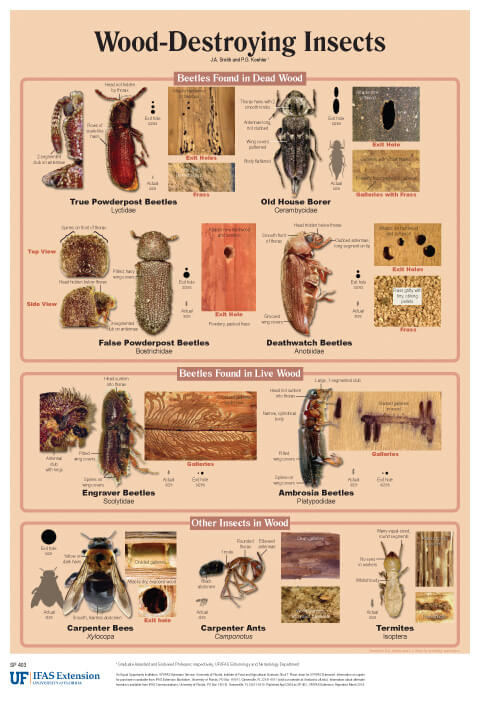Termite/Wood Destroying Insect Inspection (WDI)
This is an examination of the structure to determine the presence of any wood destroying insects. This service is typically performed at the same time as the general inspection and is performed by a third party state licensed inspection company.
Several types of insects damage or infest wood and wood products. This damage occurs over a long time (months). With few exceptions, the common denominator for this activity is excessive wood moisture levels. This moisture can be due to roof leaks, plumbing leaks, unvented crawl spaces and attics, or construction defects such as wood soil contact. Do not panic and seek an immediate remedy. Take your time to accurately identify the pest, and to assess the amount of actual and potential damage.
Not sure if you have termites? Are you seeing any of these signs in your home? If so give us a call!
Signs there may be Termites in your home
Possible signs of termite infestation may include: Any wooden building parts (especially if they support structures) begin to “sag” unexpectedly. Thin, “bubbled” or distorted areas of paint on wooden surfaces which feel cool to the touch. Thin, small, papery wings, all the same size and shape, 3/8 – 1/2 in. long, on your window sill, counter top or floor (especially if it is late spring and there has been a recent rain.) Pencil-sized diameter, or larger, mud tubes running across bare concrete or masonry between the soil and any wooden part of your building.

Normally in the Midwest, termites can swarm several times a year (typically in the spring). Our termite inspectors are trained to look for the swarming type of termite and report on its presence (along with all other termite evidence).
“They’re eating you out of house and home!” It’s a phrase you can use quite literally if you’re talking about termites, carpenter ants, carpenter bees or any of the wood destroying insects we see here in Missouri. Overall – just know it is always good to get an unbiased opinion from a licensed professional. When going through the home, we also do the inspection for signs of damage, signs of trails and physical evidence. The key for home owners is to have some knowledge about the signs of wood destroying insects and making a consistent effort to watch your own home and use standard preventive measures on your home.
Preventive measures you can take
You can do several things as a home owner to help prevent termite infestations including: Change your outdoor lights from “white” bulbs to some yellow or pale amber, especially during the spring, to reduce attraction of any night -swarming termites near your house. Relocate frequently-watered gardens or flower beds as far away from your home’s perimeter as you can.
Monitor moisture levels and take steps to reduce moisture build-up in any crawl space. Repair any leaking water lines or fixtures, especially if they wet any wooden part(s) of your house. Repair any eaves, downspouts, gables or shingles, which allow wooden parts of your house to get wet even occasionally.
Move all wood-containing mulch (even cedar or redwood) and decorative wood chips at least one foot away from your foundation. Sand and stones can be just as attractive an alternative and they discourage pest (including termite) harborage next to your building.
Stack all firewood, lumber or other wooden items several feet away from your building. Keep all wood supports of porches, patios, decks, or separate buildings more than one foot from contact with your home’s foundations; and use only pressure-treated wood for all construction which contacts the ground. Even treated wood has a limited protection period.
General Information
After a termite colony reaches a certain population level, usually more than 10,000 subterranean winged, reproductive termites, “SWARMERS” are produced and leave the colony in a “swarm.” A swarm is a mixed group of roughly 50% male and 50% reproductive females which leave the nest at the same time. Usually this occurs in a short period of 5-45 minutes. Swarming is usually triggered by a rain in the spring along with warming temperatures and lengthening days. Often this typically occurs usually around dusk or dawn. Large colonies may release swarmers in several pulse-like groups over two or more days when conditions are right.
The queen can produce roughly 1,000 eggs per day by her fourth year of life.
Swarmers fly upward at first and may be attracted to light.
Do you have Termites or Ants?
All termites have a “thick waist” where their abdomen is joined to their middle body region (thorax); but all ants have a “pinched-in-waist” at that point. All termites have antennae that look like a “string of beads;” but all ants have “elbowed” antennae. Termite swarmers have two pairs of long narrow, wings with very few clearly visible veins, and both the front and back pair are nearly equal in size and length. Winged ants have two pairs of wings with several distinct cross veins, shaped like long triangles, and the back pair is much shorter than the front pair.
Interesting Facts
- The total weight of all termites in the world is greater than all the humans in the world.
- Termites cause about $800 million in damage each year in this country, more than all fires, storms and earthquakes combined.
- Seven to eight percent of the general population is allergic to cockroaches.
- Carpenter ants derive their name from their habit of chewing galleries into wood and leaving sawdust piles around the entrance to the nest.
- Insects represent three-fifths of all living species- plants and animals combined.
- German cockroaches are most commonly introduced into buildings through paper products, grocery bags, cardboard boxes, drink cartons, and second hand appliances.
- Worker ants can live up to 7 years, while the queen ant can live as long as 15 years.
